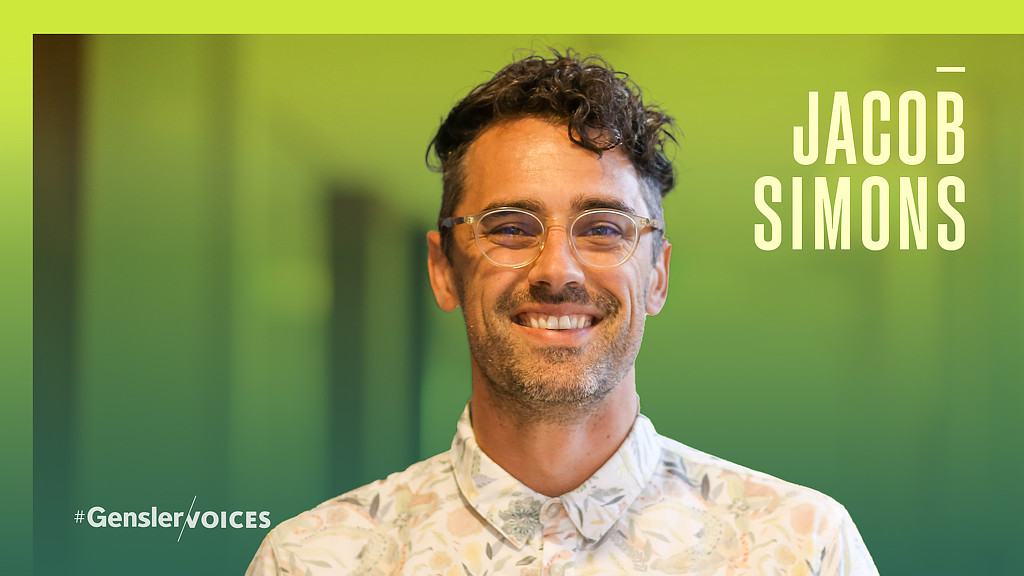Gensler Voices: Jacob Simons on the Power of Community
This Q&A is part of a series of interviews with Gensler architects, designers, and others in the firm about their career journey, and the impact that design and architecture can have on our communities and the human experience. Here, we sit down with Jacob Simons, Gensler Seattle:
Did you have a mentor growing up or at any point during your career? If so, how did that relationship impact your growth as a person or in the industry at large?
My father George Simons Jr., my grandfather George Simons Sr., and my grandfather John “Jack” Lorge. All strong men who lead through character and discipline, self-determination and hard work, sacrifice and service to their family and faith. As a young man, I had a propensity to ignore explicit direction quite efficiently, but I was very attentive to the behavior of men and women around me — parents, coaches, teachers — and the effect it had on their life, the lives of their family, and the impact they created within their communities. There was no mistaking it — those whom I admired faced all the same discomforts, suffering, and hardship of others, but persevered in the pursuit of something greater than themselves, as we all benefited from them. I aspire to be one of these men, called to service to others.
How do diverse backgrounds and experiences make Gensler a better design firm?
We all drag the chains of bias. No matter how many self-actualization practices and yoga classes, books and podcasts, and meditations and conscious leadership training we embrace (do all that stuff!), you cannot fully break free of your own beliefs and conclusions. Only when we submit to community with others who don’t look or think like us, and cultivate dissent and question, might we begin seeing evidence that doesn’t serve us, but rather stretches us. If we want to be better, we must focus beyond ourselves.
If you could impart any piece of advice to individuals beginning their design career, what would it be?
Practice humility in life and work. Unless we master the art of asking questions, listening well, and holding space for wonder and imagination for long periods of time before we “know” the solution, we will never be great designers. We may even solve problems that don’t matter and make the world a worse place, spending precious resources on things nobody needs or desires.
What’s life at Gensler like?
Fast. Expansive. Unyielding to challenge. Gensler has its sights set on building and impacting much that is not easily achieved. The pressure is real, and we are committed.
What’s the best career decision you’ve ever made?
Complementing my love for Industrial Design with a degree in Social Science. And taking six months off, after 10 years in the design profession, to wander Italy and rediscover myself as a person and as a creative.
How has your work mindset shifted as you’ve advanced in your career?
Becoming a husband and father of three beautiful children has made me think about generation problems with more passion than before. I want to leave this world better than we found it, for all our kids who will inherit it.
How can architecture and design make space that’s inclusive for everyone?
By fully appreciating the nuance and complexity of what “for everyone” truly means. Spaces for a particular activity or experience — work, healing, play, learning, entertainment — is a familiar challenge, but attaining this aim for everyone wholly is another matter.
Complexities abound; questions frame what we must overcome as creatives. How do we address neurodivergence? Specifically, how will space reduce sensory overload while appreciating, for those who are hyposensitive, vibrancy and novelty may stimulate attention, while the hypersensitive may require calm order and serenity to avoid immediate overwhelm. How do we address access? There are complex, systemic conditions that allow, or discourage, participation before a space is even entered. We must be thinking holistically about the human journey to and through space beyond our neat scope of work should we claim, “for everyone.” For example, higher education for everyone isn’t about classroom design alone, because some children lost their hope and opportunity to excel on a campus decades ago. Design has a profound challenge before it and spaces FOR everyone begin with engaging in the dialogue about our society, community, and systems of influence that govern for whom places are truly designed.
For media inquiries, email .
